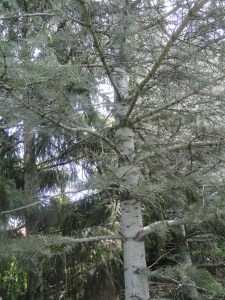Tolerant to shade, drought, and resistant to most pests and diseases, White Firs are some of the healthiest and “best” conifers available. They thrive at high altitudes and grow as excellent holiday trees. Their root system is adaptive to different soil conditions, although it dislikes very acidic, alkaline, and heavy/clay soils. Many varieties are commercially available, especially in the western United States.
Abies concolor (White Fir, Concolor Fir)
Deciduous: no
Hardiness Zones: 3-7
Height: 12-21 meters (40-70 feet) tall in cultivation, 24-39 meters (80-130 feet) tall in native habitats
Diameter: 6-9 meters (20-30 feet) wide
Growth Rate: similar to Fraser Fir, highly variable, typically slow but occasionally rapid, upto 45 centimeters (18 inches) annually
Age: Cone production usually doesn’t begin until 40 years of age. Some reports claim some White Firs to be 500 years old.
Root System: may be deep and pervasive in lighter soils (taproot-like) or shallow and wide where water tables affect soil depth, surface roots not a problem
Family: Pinaceae
Subspecies: var. lowiana (in California, where rainfall and temperatures are higher), var. concolor (in the Rocky Mountains, where rainfall is lower), ‘Blue Cloak’ (slow-growing, weeping form), ‘Candicans’ (most blue), ‘Conica’ (slow, upright, conical), ‘Gable’s Weeping’ (wind-swept form), (dwarf compact, may reach 6 feet in 10 years of growth)
Tolerates: drought (especially var. concolor), shade (more so than other conifers), light fires (at old ages, although these open up new entry points for pests and diseases)
Problems (major): none, fairly resilient
Problems (minor): Heavy/clay soils negatively affect growth and health. Bark beetles, spruce budworms, aphids, bagworms, scale, rust (rare), cankers, balsam woody adelgid, root rots, strong winds (especially for taller specimens), urban pollution, and fungal infections (at damaged areas) are all detrimental.
Poisonous: Terpines may cause pain if ingested. Contact with Concolor Firs may cause dermatitis in some.
Soil requirements: prefers mineral or nutrient rich soils, requires moderately acidic soils with good drainage, tolerates medium/loamy and light/sandy soils, dislikes very acidic, alkaline, and heavy/clay soils
Air requirements: intolerant of poor air quality
Watering requirement: moderate
Sun requirement: prefers full sun, tolerates part shade
Needles: up to 7 centimeters (2.5 inches) long
Cones (male): yellow to red, catkin-like
Cones (female): elliptical, up to 6 inches long, yellow to green when immature, purple or brown at maturity
Seeds: oblong, light brown, with wing
Leaves: none
Flowers: none
Fruits: none
Bark: gray, smooth when young, furrowed when older
Seeds require stratification: yes
Monoecious or Dioecious: monoecious
Notable characteristics:
The overall shape is narrow and conical. These are present, and thrive, in high altitudes, up to 9,000 feet.
Uses:
White Firs are commonly used as Christmas trees. Although not extremely popular, these conifers perform significantly better than most others. Occasionally, White Firs have been used for a variety of medicines.
Sources used:
- http://www.missouribotanicalgarden.org/PlantFinder/PlantFinderDetails.aspx?kempercode=c201
- http://www.na.fs.fed.us/pubs/silvics_manual/Volume_1/abies/concolor.htm
- http://hort.ifas.ufl.edu/database/documents/pdf/tree_fact_sheets/abicona.pdf
- http://plants.usda.gov/core/profile?symbol=ABCO
- http://dendro.cnre.vt.edu/dendrology/syllabus/factsheet.cfm?ID=94
- http://www.hrt.msu.edu/assets/pagepdfs/bert-cregg/concolor-fir-w-cover.pdf
- http://medplant.nmsu.edu/abies.shtml
- http://plants.ces.ncsu.edu/plants/all/abies-concolor/

A mature female cone, sitting upright

A White Fir at the Denver Botanic Gardens in Colorado, foliage and bark visible

Several mature, purple, female cones atop A. concolor
All of the images provided were taken by me at the Denver Botanic Gardens in June 2014. They may be used for educational/informational purposes only, provided that this article/online journal is appropriately cited first.

